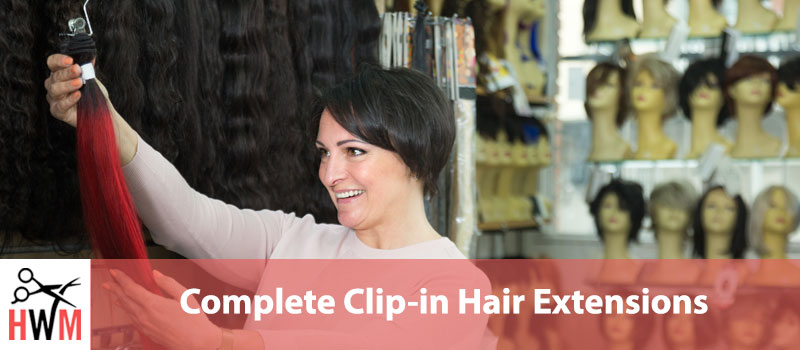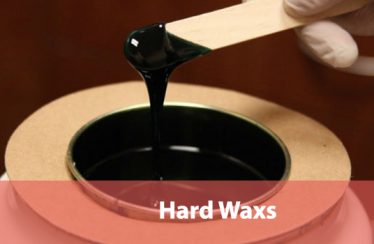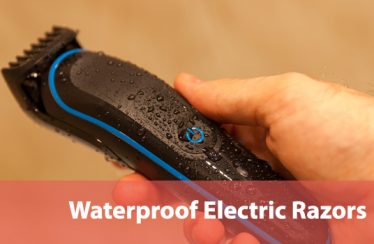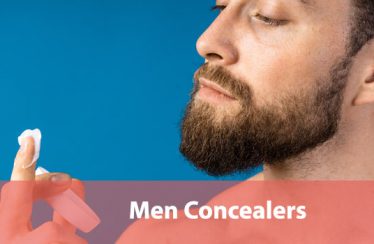Clip-in hair extensions are the oldest type of hair extensions. In fact, for the longest time, clip-in hair extensions were the only way women could hide hair loss. However, the introduction of new types of hair extensions such as glue-in and sew-in has slowly eroded away the popularity of clip-ins.
In recent years, though, the rise of Do-it-Yourself (DIY) culture has seen clip-ins become famous again. More importantly, if you’re new to the world of hair extensions and are looking to dip your toes in before taking the full dive, clip-in hair extensions offer the perfect avenue.
Whether you’ve been watching clip-in hair extension DIY videos on YouTube or you want to play around with the way your hair looks, you’ve come to the right place. This page represents the most comprehensive guide on clip-in hair extensions you’ll find anywhere online.
It contains everything you’ll ever need to know about clip-in hair extensions, including what they are, how to use them, and even how they respond to metal detectors. In case you’re looking for specific information about clip-ins, feel free to jump around the page with the help of the following clickable navigation panel.
- What is a Clip-In Hair Extension?
- What Are the Different Types of Clip-In Hair Extensions?
- How Much Do Clip-In Hair Extensions Cost?
- How Many Clip-In Hair Extensions Will You Need?
- How Long Do Clip-In Hair Extensions Last?
- Will Clip-In Hair Extensions Damage Your Hair?
- How to Wear Clip-In Hair Extensions and Blend them in Properly?
- Will Clip-In Hair Extensions Blend Well in Short Hair?
- Will Clip-In Hair Extensions Feel Weird After Installation?
- How Should You Wash Your Clip-In Hair Extensions?
- Can You Sleep with Clip-In Hair Extensions?
- Can You Swim with Clip-In Hair Extensions?
- Will Clip-In Hair Extensions Set Off Metal Detectors?
- How to Take Care of Your Clip-In Hair Extensions?
What is a Clip-In Hair Extension?
Clip-in hair extensions are, essentially, wefts of hair or sections that have been fixed on clips. They’re used for a wide variety of purposes.
For the longest time, clip-ins were used primarily by people enduring hair loss.However, in recent decades, they’ve become a favorite of experimenters too. These are people who not only like trying out new hairstyles but also flipping through them on a whim.
Clip-in hair extensions can be found online or offline from a wide variety of sellers and manufacturers. Moreover, they can also be made at home. If you go looking for clip-ins in the market, you’ll find everything from generic options to branded ones. Their quality will vary based on the type of hair used to manufacture them and the brand under which they’re being sold.
What Are the Different Types of Clip-In Hair Extensions?
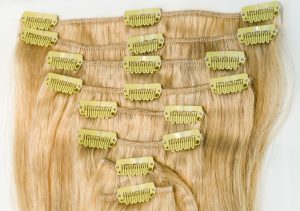
Clip-in hair extensions are mainly categorized on the basis of the type of hair used to manufacture them. From this perspective, there are four varieties of clip-in hair extensions – synthetic hair, virgin human hair, human hair, and Remy human hair clip-ins.
Synthetic hair clip-in extensions are made up of hair that is usually a type of plastic or polymer developed to resemble human hair in appearance. While it looks like human hair, it doesn’t behave like one i.e. the way it falls and flows isn’t natural. As synthetic hair is mass-produced, synthetic clip-in hair extensions are extremely cheap and affordable.
Virgin human hair clip-in extensions, as their name suggests, are made with unprocessed human hair. This type of hair is collected from donors’ scalps so as to ensure its natural appearance and movement.
The term virgin is used for this type of hair because it is completely unprocessed. Between virgin human hair and synthetic human hair, another variety exists – plain human hair. It is different from virgin human hair because it is chemically processed. The chemical process this type of hair goes through can vary greatly.
The best human hair subcategory is only chemically sanitized or cleaned. The worst type will be human hair whose cuticles have been stripped and replaced with artificial concoctions comprising silicones and conditioners. The more chemical processing the hair has gone through, the less durable and natural the clip-in hair extension is going to be.
This is precisely why Remy human hair clip-in extensions are considered to be the best. Remy human hair, like virgin human hair, is also directly obtained from donors. The difference between the two is the orientation of their cuticles.
Remy human hair, right after collection, is carefully arranged so that the cuticles on all hair strands are pointing in the same direction. This makes Remy human hair even more durable, long-lasting, and natural than virgin human hair.
It also means that all Remy human hair is virgin human hair but all virgin human hair is not Remy human hair. Because of the painstaking and time-intensive collection process of Remy human hair, clip-in hair extensions made of this type of hair are the most expensive.
Clip-in human hair extensions can also be categorized based on the source of human hair i.e. the country it comes from. Human hair is generally sourced from developing nations such as Peru, India, Malaysia, Brazil, Vietnam, Mongolia, the Philippines, and Cambodia.
How Much Do Clip-In Hair Extensions Cost?
Of all the different types of hair extensions, clip-in hair extensions are the cheapest.
They’re more affordable than tape-ins, glue-ins, and protein-bond hair extensions because they’re so easy and cheap to manufacture. Additionally, since clip-ins are so easy to install at home, most women to choose to attach them without the help of professional stylists.
This has been made even easier with so many stylists making DIY videos on clip-in hair extensions. In contrast, when it comes to other types of hair extensions, most women choose to get them installed from expert stylists to avoid irreversible mistakes.
As a result, the cost of installation needs to be added to the total cost of those hair extensions. Since clip-ins can be installed at home without significant risks, the total cost of using clip-in hair extensions is nothing but the cost of acquiring the extensions.
If you’re wondering about how much you’ll have to pay to get clip-in hair extensions, it will vary based on two variables – type of hair and expected outcome.
As we explained in the previous section of this guide, the cheapest type of clip-in hair extension is one made with synthetic hair while the most expensive is Remy Human hair.
Virgin human hair is slightly less expensive than Remy human hair while plain human hair is slightly more expensive than synthetic hair but still more affordable than virgin human hair.
The amount of money you spend on clip-in hair extensions will also vary based on what you expect the outcome to be. If you’re losing hair and are looking to get clip-ins for the purpose of adding length and volume then you’ll need lots of long wefts.
You will also need a lot of wefts if you have short hair and want to make them look by using clip-ins. In contrast, if you’re only looking to add highlights to your hair, then you won’t need as many wefts.
Getting more wefts, obviously, means more spending.
How Many Clip-In Hair Extensions Will You Need?

Two things will define how many clip-in hair extensions you will need – the thickness of your hair and the length of your hair.
If you have very thick hair, then you’ll need to buy a whole pack of clip-in hair extensions. Typically, and assuming that one weft contains 20 hair strands, a pack can contain anything between five to nine wefts.
If you have short or medium, thick hair, then you’re likely to need even more wefts. The reason for this is that blending wefts into short hair is more difficult than longer hair. In fact, the requirement can go as high as 12 wefts for women who have this type of hair.
On the other hand, if you have very thin hair, then it is likely that you can get the effect you’re looking for with very few wefts. On average, most people need a minimum of five wefts.
How Long Do Clip-In Hair Extensions Last?
Clip-in hair extensions last the longest of all hair extensions, especially if they’re maintained well. Even without extreme maintenance, high-quality clip-ins such as those made with Remy human hair will stay with you for up to six months.
This is huge when compared to the lasting time of other types of hair extensions. The longest other types of hair extensions will last you is eight weeks.
The reason why clip-in hair extensions last this long is that, unlike all other types of hair extensions, they don’t stay in your hair all the time. As a result, they don’t have to face the shower as often as others or even deal with the tangling that can occur while you sleep.
In fact, the less you wear your clip-in hair extensions, the less they’ll be exposed to the elements and the longer they will last. Some women use their clip-in hair extensions for years by only wearing them on special occasions.
Will Clip-In Hair Extensions Damage Your Hair?
Many women think that clip-in hair extensions will damage their hair. This is a myth that puts off many women from even considering using clip-in hair extensions.
This belief is so grossly wrong that if more of them knew the truth, the world would run out of clip-ins very quickly. There’s a reason why this misconception exists, though. That reason is that all other types of hair extensions can damage hair in some form or another.
The glues and adhesives used in other types of hair extensions can be very difficult to remove which is why it is so easy for them to damage hair. Similarly, keratin bonding affects the hair at a molecular level adversely. Clip-ins are the only type of hair extensions that don’t damage hair, especially if they are of good quality.
For instance, branded, premium-quality clip-in hair extensions boast of high-quality clips with rubber linings that prevent them from slipping and damaging hair. Many even have multiple clips spaced apart carefully to prevent even the weight of the hair extension from pulling the hair.
The only way that clip-in hair extensions can damage hair is if they’re not used in the right way. For instance, if you try to wear clip-in hair extensions while sleeping then there could be some breakage and crimping.
Similarly, clip-ins aren’t designed to be worn for more than a few hours. If you attempt to wear them throughout the day for multiple days in a row, you will see some damage. However, this applies to all types of headgears. Even if you wear caps for the whole day for multiple days running, you’ll see hair damage.
Further, if you’re casual about the way you use your clip-in hair extensions, you can end up damaging your hair. If you don’t install the clips or remove them carefully enough, you can end up pulling or breaking your own hair.
The biggest proof of this is that most instances of hair being damaged by clip-in hair extensions is during the installation and removal process.
How to Wear Clip-In Hair Extensions and Blend them in Properly?
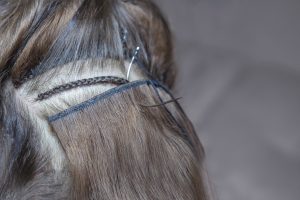
It can be quite embarrassing if people can tell that you’re wearing clip-in hair extensions. After all, you got them to look better and more attractive not to look pretentious.
And yet, there are countless horror images online of women who have failed to do just that. So, what can you do to avoid this problem? The answer is to blend your extensions with your hair better.
The first thing you need to do this is tomake sure that you get clip-in hair extensions that match your natural hair and wear them properly. Most women think that matching hair extensions to natural hair is about hair color. They’re right, of course. It is but it isn’t just that.
It is also about matching the texture of the hair as well. If you’ve matched the hair extension’s color and texture with your hair well, then you’re halfway to avoiding future embarrassment.
Now, you only have to make sure that you’re wearing the clip-in hair extensions properly. Fortunately, the process is not that difficult if you know what you’re doing. Here are the steps you’ll need to follow.
Step 1: Parting and Sectioning your Hair
The process begins with you parting your hair like you normally do. While parting through the middle will make things the easiest for you, it isn’t critical to the process.
After you’ve parted your hair normally, you’ll also have to part your hair vertically. The location of this parting will be right above your ears or perpendicular to the first part. You should part your hair vertically on both sides so that a line goes up from the tip of one ear to the tip of the other ear.
As you part one side, use clips to hold the hair towards the front. Do the same on the other side.
Step 2: Attaching Hair Extensions to the Back of the Head
To begin attaching hair extensions to the back of your head, you’ll have to section some more hair.
Begin by sectioning off the bottom-most inch of your hair below the occipital bone. The occipital bone forms the base of your skull so you can section off the last inch or so of your hair.
The next step will depend on the kind of hair extensions you have. If you have wide wefts of clip-in hair extension, then things will be easier. Wider wefts usually come with two spaced apart clips.
You can measure the distance between the clips and then, using the information, create subsections of the hair you’ve sectioned at the base of your skull. You’ll end up with two thin sections and will have to either braid them together or tie them using hair elastics or rubber bands.
Once done, you can attach the clip-in hair extension to the tied off sections of hair. You’ll have to repeat this step till you reach the crown of your head. Each time, you’ll move half an inch higher to make a new section and attach a new hair extension. Before moving from one weft to another, make sure that you straighten and brush the weft you’ve just attached.
After you’ve made the final horizontal section, though, the process becomes a little different. At the top, you’ll be making four vertical sections and tying them off. If you parted your hair in the middle, the vertical sections will be spaced apart equally. If you didn’t, then you’ll put two vertical sections on the side with more hair, one at the back, and one on the side with less hair.
You can attach a clip-in hair extension to each of these sections and the result will be more added hair to the part that has more natural hair. This will allow the entire combo to look more real.
Step 3: Attaching Hair Extensions to the Side of the Head
After attaching all the hair extensions to the back of your head, you’ll also have to attach a couple to the side to complete the look. If you don’t, it will seem like you have more hair at the back than on the side, which is a clear sign of hair loss or artificiality.
On both sides of the partition, move up another half an inch and create one more vertical section of hair. On each verticle section, attach a single clip weft or hair extension. Check how you look and if things look imbalanced, add another weft to the side with more hair. Also, make sure you brush and straighten each of these extensions.
Will Clip-In Hair Extensions Blend Well in Short Hair?
The vast majority of women believe that clip-in hair extensions are only for medium to long-haired women. In fact, even some stylists think that clip-ins cannot be used on short hair because they become too easy to spot. That isn’t entirely true.
There are things you can do to ensure that your clip-in hair extensions blend even with your short hair. However, this is only possible if your hair is not shorter than six to seven inches. This length amounts to shoulder length hair for most women. The reason why hair needs to be this length is obvious. Any shorter and your natural hair will neither be able to hold on to the wefts nor hide them well enough.
Even with shoulder-length hair, it is difficult to blend clip-in hair extensions. Like, we said, though, it isn’t impossible. It is just a little more elaborate. Here are tips to ensure that clip-in hair extensions blend with your short hair.
Hide the Bottom Most Section
One of the reasons why it is so difficult to blend hair extensions with short hair is the telltale short hair strands located at the nape of the neck. These short strands stand out and give away the truth even if you try to cover them with long extensions.
The trick to dealing with these short strands is to take the entire bottom-most section of hair and pin it up. This way they won’t be able to peek out from under your long hair extensions.
All you need to do is gather the section into braids and pin the same to the back of your head. The braids you pin together can then be used as the staging area for the very first clip-in extension in your hair.
Get Lots of Wefts
You can never have enough wefts if you have short hair and want to use clip-in hair extensions. In fact, the more you have the better it will be for you.
As explained in a section above, short, thick-haired women need the most wefts to blend the hair extensions with their natural hair. Depending on how short or thick your hair is, you should get anything between 12 to 16 wefts for your hair.
Attach Them as High as Possible
When it comes to blending clip-in hair extensions with natural short hair, the best thing to do is hide the short hair behind extensions completely. This is why you need so many wefts in the first place.
However, as you attach these wefts, you’ll realize that you’re running out of space. You’ll be tempted to squeeze them in closer together, but don’t. Instead, keep the spacing between them normal and just go higher than you would normally.
Get Two Or More Colors
This is a secret trick of the most advanced stylists. Blending clip-in hair extensions is significantly easier if you have wefts of varying colors since this adds dynamism and depth to the entire setup. As a result, the hair extensions will blend better with the natural hair.
We recommend getting at least two complementary colors, but if you can get more then blending will become even easier. As to how you should attach clip-in hair extensions of different colors, the trick is to simply alternate or cycle through your chosen colors one by one.
Curl Them or Add Waves
Curls and waves in your hair extensions offer the same benefits that wefts of multiple colors do i.e. dynamism and depth. This means that curls and waves also help blend extensions with natural hair.
It is incredibly easy to add curls and waves to hair extensions too. You can simply use a curling iron on them before attaching them in place. After you’ve attached them to the respective places, though, we recommend curling them in pairs to create synergy.
Also, you need to remember that you cannot curl synthetic or heavily processed human hair. The heat from the curling rod will ruin the hair. This tip, therefore, is only possible with virgin human hair and Remy hair.
Maximize the Widest Section of Hair
Another way of squeezing in more wefts into the limited area on the scalp is to maximize the widest section on your scalp. The widest section on your scalp will be level with your eyebrows and the imaginary line will pass just above your ears.
Maximizing this space just means putting more wefts in a line. Most women should be able to fit in six clips into this space. It is up to you if you want the wefts to be a single clip, double clip, or triple clip.
Try to Frame Your Face
Blending hair extensions means making everything look natural. Short hair frames the face differently from how long hair frames the face, however. Therefore, if you’re attaching long wefts to your hair, then the shorter strands around your face will make things look unnatural.
To fix this discrepancy, you can place some face-framing wefts to the side of your hairline. There are two ways to do this. Either you buy shorter wefts of the same type or you buy longer matching wefts of human hair and trim them to the right length.
Will Clip-In Hair Extensions Feel Weird After Installation?
You have to realize that putting on hair extensions means carrying extra weight on the head. Even though clip-in hair extensions aren’t super-heavy, they do have some weight that you’ll have to get used to. Till you get used to it, though, you will have to account for the weirdness of extra weight on the head.
Women with thin, fine hair are likely to take longer to get used to the extra weight since fine hair tends to be very light. One of the ways of getting around this problem is to start with a fewer number of wefts and increasing them as you get used to the extra weight.
It is also possible that extra-sensitive women may feel extra pressure on their scalps owing to the clips being installed there. There are two solutions to this. The first is to get hair extensions with double clips and the other is to move the placement of the clip-in hair extensions farther away from the scalp.
In a nutshell, you should know that any weirdness, extra-weight, or extra-sensitivity you may feel because of your hair extensions will pass as you get used to them.
How Should You Wash Your Clip-In Hair Extensions?
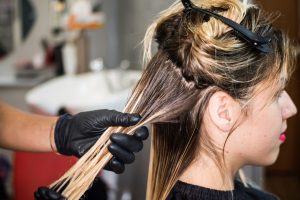
While you’ll have to change your entire bathing regime to cope with the permanence or semi-permanence of other types of hair extensions, you can just take off the clip-in hair extensions. This is why, unlike other types of hair extensions, clip-in hair extensions are much easier to wash, moisturize, and dry.
It also means that you can minimize the washes. This is good because the more you wash your hair extensions, the quicker they’ll go bad. Besides, since clip-in hair extensions don’t receive the oils produced by your scalp, they don’t need to be washed frequently anyway.
In fact, even if you wash them every 10 to 15 sessions, you’ll still have clean extensions. However, when you do wash them, you have to be careful with them because you can’t deal with them the same way that you deal with your natural hair. They are, after all, more fragile than your natural hair. So, how should you wash them? Here are the steps.
Step 1: Arranging and Brushing Clip-in Hair Extensions
While you can wash each weft individually for the sake of maximum cleanliness and care, you’ll save tons of time by clubbing them all together. You can do this in two ways.
The first is the wrap-around i.e. single clip wefts wrapped by double clip wefts, which are then wrapped with triple clip wefts. It is likely that this is how you received your clip-in hair extensions in the first place because it is the most stable and protective arrangement for the wefts.
The other method is to simply take them all together in a clump and tie off the clip side with a hair elastic. Incidentally, even if you choose the wrap-around technique, we suggest tying the wefts together.
Once you have them arranged, you should go about brushing them carefully. Avoid brushing them from top to bottom and instead,do the opposite i.e. bottom to top. This will prevent undue pressure from being applied to the clip and weft joint.
Make sure that you’re either using a wide-toothed comb or a micro-loop hair extension brush.
Step 2: Washing and Conditioning Clip-in Hair Extensions
There are two ways that you can wash and condition your clip-in hair extensions. One is to use running water and the other is to use standing water. Neither technique is better than the other, so your choice depends on your preferences.
The washing process will begin with you wetting the hair extension bundle. You can do this by either dipping the bundle in lukewarm water or running lukewarm water over it. Once the wefts are damp, you can apply your chosen shampoo.
We recommend using a shampoo solution i.e. shampoo mixed in some water, instead of applying it directly. The reason for this is that most shampoos are thick in consistency which can make it very difficult for you to spread them through the bundle. If you insist on trying, though, be very careful that you don’t tangle the hair by rubbing too hard.
If you’re sure the shampoo has penetrated deep enough, rinse off the bundle. Rinse three to four times to make sure that shampoo hasn’t been left behind. After you’re done with the shampoo, you can apply conditioner to the bundle.
Again, you can make a conditioner solution for more convenient application and penetration. Make sure the conditioner goes deep as hair extensions are always starved of moisture. Leave the conditioner in your hair extensions for a few minutes before rinsing it out. Rinse multiple times to remove all traces of the conditioner.
Step 3: Drying Clip-in Hair Extensions
Once you’ve rinsed off the excess conditioner, you’ll be left with a damp weft bundle. To dry it, use a microfiber towel instead of a cotton towel.
Cotton tends to snag and pull hair which is why using a cotton towel can result in the hair extensions getting damaged. Microfiber towels will neither snag hair nor tangle it, so long as you’re gentle.
Dab and squeeze the wefts instead of rubbing them. Once the excess moisture has been soaked by the towel, you should let the weft bundle air dry. We advise against using a blow dryer on your hair extensions. Hair extensions of any type don’t take well to hot tools because the heat generated tends to damage them.
Step 4: Moisturizing Clip-in Hair Extensions
The biggest problem with clip-in hair extensions or any other type of hair extensions is that they don’t benefit from the oils produced in the scalp. The oils have a dual role when it comes to our natural hair. They keep the hair moisturized and protected from adverse external influences. When it comes to hair extensions, this limitation has to be compensated for artificially.
Leave-in conditioners and deep conditioning treatments are great for this purpose. You can use leave-in conditioners daily in small quantities, and deep condition your extensions every 30 wearing sessions or so.
Your hair extensions will take some time to absorb the moisture offered by the deep conditioning treatment. Give them this time by letting them sit with the deep conditioner for up to six hours.
Can You Sleep with Clip-In Hair Extensions?
Clip-in hair extensions have one flaw that other types of hair extensions don’t. This is the fact that you cannot sleep with them. Remember, we explained that clip-in hair extensions cause no damage to natural hair unless misused? Well, sleeping with them in your hair counts as misuse. Here’s why.
When we sleep, we toss and turn. When we toss and turn, our hair is pulled and yanked in multiple directions. This physical stress can lead to horrifying tangles at best and breakage at worse.
You probably wake up every morning with tangled hair on your head and broken hair on your pillow anyway. If you sleep with clip-in hair extensions, you’ll wake up with even more tangles and breakage because of the clips in your hair.
At the same time, we understand that sometimes it is not possible to take special care of your hair and hair extensions. If you’re stuck in a situation where you cannot take them off before going to bed, then there are two things you can do to protect your hair and extensions alike.
Shut the Clips Tightly
Before you go to bed, you have to make sure that every clip of the clip-in hair extensions is secure. In fact, you should shut them as tightly as humanly possible because if they’re loose, they’re going to cause mayhem in your hair.
As you move around in your bed, the loose clips will move around in your hair and tangle them in the most horrible way possible. It is even possible that they’ll get stuck in the pillowcase or the sheets and cause even more damage to your hair.
All these things, though, will only happen if the clips are not secure in your hair. Another thing you can do to prevent these problems from occurring is to change your linen from cotton to silk since silk doesn’t snag hair and clips.
Cover Your Head Completely
In addition to securing the clips of your clip-in hair extensions tight, it is also advisable to cover your hair entirely. You can do this in various ways. The simplest would be to wear a silk scarf around your hair. You can also try other types of sleeping headgear such as a bonnet or hoodie.
By covering your hair, you’re creating a barrier between your hair and everything else. This will prevent the clips from moving within your hair. Further, the covering will also prevent you from scratching your own scalpwhile deep asleep.
An involuntary scratch in half-sleep can result in hair damage if you’re wearing clip-in hair extensions. Usually, the scratch is fueled by the clips themselves. When a clip touches your scalp, you could get the sensation of an itch resulting in the need to scratch.
Can You Swim with Clip-In Hair Extensions?
It is never a good idea to go swimming with any type of hair extension in your hair. Hairpieces, regardless of their type or installation procedure, just aren’t designed to handle that kind of treatment.
The reason is, again, the fact that hair extensions don’t receive the protection provided by oils that our natural hair enjoys. It doesn’t even matter which kind of water body you’re planning to swim in. Everyone of them can damage your hair extensions in one way or another.
For instance, if you dive into a swimming pool, chemicals in the water such as chlorine will affect your hair extensions adversely. Similarly, if you take a dip in the ocean, then the salt will eat away into your hair extensions.
Even if you swim in freshwaterbodies such as lakes or rivers, the dirt in the water will end up coating and damaging your hair extensions. In fact, the salt in your sweat can end up damaging hair extensions too. This is why it is not recommended to wear them while exercising and working out.
Even if you take care of all these problems, the fact that your hair extensions are very prone to tangling means that swimming with them on is not recommended. By the time, you step out of the water, you’ll have a tangled mess that will even include your natural hair. This is even more likely with clip-in hair extensions because your natural hair will tangle with the clips.
Ideally, you should take off your hair extensions before going swimming. However, if this is not possible, then you have to, at the very least, cover your hair and hair extensions.
Will Clip-In Hair Extensions Set Off Metal Detectors?
This is a genuine worry for women who travel a lot. The easiest way around this problem is to choose hair extensions with plastic clips. The only concern with plastic clips is that they may not shut properly or last long enough. However, if you buy high-quality clip-in hair extensions, then you won’t have to worry about these problems.
Unfortunately, clip-in hair extensions with plastic clips aren’t easy to find. Moreover, high-quality clip-in hair extensions with plastic clips are even more difficult to find. Besides, clip-ins with metal clips offer both reliability and longevity.
This brings us back to the question of whether the clips will set off metal detectors in various places. The concern is particularly serious when it comes to airports because their metal detectors tend to be very sensitive. Whether metal clips of clip-in hair extensions will show up in airport metal detectors or not depends on their quantity.
If you only have a few in your hair, then the chances of the metal detectors going off are low. However, if you’re trying to make your short hair look longer, then you’ll have a lot of clips in your hair and they will set the metal detectors pinging.
If this happens, then you’ll be at the mercy of the person in charge. Some people say that security is nice enough to let people go after verifying that it is really just clips in their hair. Others, however, say that the security makes people take their hair extensions off. Therefore, the nature of the security personnel will determine how they deal with you if your clips set off the detectors.
You should also know that the personal metal detectors carried by airport security are much more sensitive than full-length metal detectors.
How to Take Care of Your Clip-In Hair Extensions?
As we’ve said countless times already, maintaining hair extensions is no easy task. They need special care, regardless of their type. A single mistake can lead to a significant reduction in their life. Therefore, it is important that those mistakes are not made.
If you internalize all the information we’ve already included in this guide, then you’ll be well on your way to maximizing the life of your clip-in hair extensions. However, keeping the following tips in mind will also help you greatly.
Avoid Using Hot Tools
Most experts will tell you not to use hot tools on your hair extensions. If you have synthetic hair extensions, the hot tools will melt them straightaway. If you have human hair extensions, then the hot tools will reduce their life.
While there is no way to use hot tools on synthetic extensions, you can use them on human hair, provided you use a strong heat protectant first. You’ll also have to keep the hot tools to lower temperatures as the heat protectant may not be able to handle higher temperatures.
Even these precautions, though, will only reduce the impact of hot tools and not negate it completely. They will still reduce the overall life of the hair extensions to some extent, which is why it is best to avoid hot tools as much as possible. One workaround would be to have two sets of hair extensions, one for the straight look and one for the curled look.
Use Mild and Gentle Shampoos
The shampoo you use to wash your hair extensions cannot be too harsh and need to be as mild and gentle as possible. This means choosing shampoos without harmful ingredients such as alcohols, parabens, sulfates, and phthalates.
In fact, it is best to avoid all shampoos with artificial formulae and choosing natural or organic shampoos instead. This is especially recommended since most organic shampoos have significant moisturizing qualities as well.
Moisturize Your Extensions Well
The biggest challenge with maintaining clip-in hair extensions is that they get dry very fast because they don’t receive the oils produced by the scalp. This means that their moisturization has to be done artificially.
The best solution is to use conditioners of various kinds. You’ll need to condition your hair extensions after every wash, use a leave-in conditioner before every wearing session, and utilize a deep-conditioning treatment every month. You’ll also have to make sure that the conditioners are natural and without harmful substances.
Trim the Ends to Push Their Life Further
The first sign that your hair extensions are going bad is that their ends will become frayed. Regardless of how well you maintain them, the lack of natural conditioning will start showing at the ends of each strand first.
Seeing this, however, doesn’t mean that you need new extensions. You can prolong the life of your hair extensions by trimming off the ends. They will get slightly shorter but this will add another few weeks of life to your hair extensions.
Contents
- What is a Clip-In Hair Extension?
- What Are the Different Types of Clip-In Hair Extensions?
- How Much Do Clip-In Hair Extensions Cost?
- How Many Clip-In Hair Extensions Will You Need?
- How Long Do Clip-In Hair Extensions Last?
- Will Clip-In Hair Extensions Damage Your Hair?
- How to Wear Clip-In Hair Extensions and Blend them in Properly?
- Will Clip-In Hair Extensions Blend Well in Short Hair?
- Will Clip-In Hair Extensions Feel Weird After Installation?
- How Should You Wash Your Clip-In Hair Extensions?
- Can You Sleep with Clip-In Hair Extensions?
- Can You Swim with Clip-In Hair Extensions?
- Will Clip-In Hair Extensions Set Off Metal Detectors?
- How to Take Care of Your Clip-In Hair Extensions?
